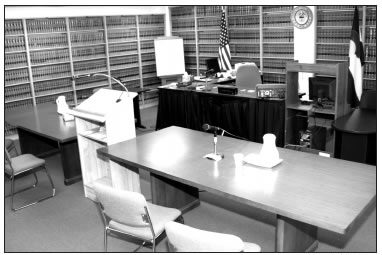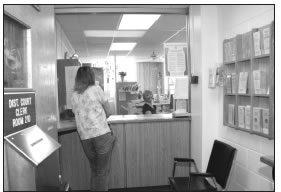Montezuma County is growing — and along with the new homes, added revenues and new roads comes a host of new problems. One of the most pressing is a need for more space for county government and the judicial system, as existing facilities have already reached their limits.

A small hearing room in the county courthouse means conflicting parties sometimes sit in close proximity. Photo by Wendy Mimiaga.
Just for the court system alone, a recent “needs assessment” conducted by the state estimated that a 40,000- square-foot combined courts building with courtrooms, judges’ chambers, court clerks’ offices, probation offices and public defenders’ offices is needed to accommodate the growing load of the local justice system. (A second judge for the 22nd Judicial District was approved by the state legislature earlier this year and this has added to the space demands.)
Montezuma County Administrator Ashton Harrison stressed that the needs assessment was for the court system only, and that a separate assessment is planned for other county offices, such as the county clerk, treasurer, assessor, social services, planning and the county extension, which are now crammed into the courthouse. The building contains about 36,000 square feet, but that includes the district courtroom, court clerks’ office and the court administrator’s office. The courthouse is also where the county commission holds its weekly meetings, but the commissioners themselves have no offices to call their own.
“The state legislature has mandated the county provide the courts with adequate space, and the courts have done their own needs assessment for court facilities and probation,” Harrison explained, “and we’re looking at doing a needs, or space, assessment for all the county functions.”
But that is going to take some time and money, he added and in the meantime the county is conducting an audit to determine how energy-efficient the present facilities are and how savings might be realized.
He said the county’s needs assessment will also be costly and he is looking for grant money to help with that expense.
The state assessment did not include the district attorney’s offices, which also are cramped as the county’s population and its attendant demands grow. That assessment was not sparked by the addition of a new district judge, Harrison explained, but was based on a 20-year projection of what case loads will be.
The space crunch is not merely inconvenient for staff; it poses security and safety problems as well.
Some rooms in the courthouse where hearings are held — sometimes regarding adult criminals, juvenile offenders and civil matters such as disputed divorces — are so small the defendants and victims, or the disputing parties and their families, are seated in very close proximity on a single row of chairs. In one room, the witness stand is almost within arm’s reach of the judge’s bench.

The court clerk’s office is so tiny that people wanting to look at files must stand at a table and people entering are advised to “open the door slowly” so they don’t hit anyone. Photo by Wendy Mimiaga.
And during breaks, the observers coming to such hearings must wait out in the halls. These sometimes-arguing parties stand where county clerk staff and others have to walk through them to get into their offices.
The aging and labyrinthine courthouse, which was built in 1937 and added onto in 1960, is not readily handicapped-accessible, either. The stairway lift at the front entrance has been out of commission for some time. Disabled persons wanting to get into the main district courtroom where jury trials are held have to be brought up via an elevator that leads to the back of the courtroom, then brought around to enter via the front entrance with its metal detector and security guard.
Disabled persons wanting to go to offices such as the clerk’s are advised by a sign to go to the Adult and Aging Office at 35 S. Chestnut, just behind the courthouse, for assistance.
Seeking funding
But while the need for more space is clear, the solution is not, particularly when it comes to funding.
Harrison said, as far as funding for the expansion of the courts with their additional space, an Energy Impact grant of up to $1 million would be possible, but funding a whole new combined court facility that could cost $10 million wouldn’t be possible with the county’s current revenue.
“Realistically, the only way to get a facility like that would be to pass a bond — just ask the voters,” he said.
“But we’re a ways away from that, and to my knowledge no one’s been pushing the county to do this tomorrow – it’s in the very initial stages.”
Ideally, he said, a new combined courthouse complex containing both the district and county courts and their clerk’s offices as well as probation, the district attorney and public defenders’ offices would be built on county land near the new jail, reducing transport needs for prisoners. (County court is now located in the aging and poorly ventilated Justice Building near Centennial Park, while district court is downtown, thus complicating transport and security issues.)
“Without the needs assessment, my gut tells me that if that were to happen, the county offices, as far as space needs, would be taken care of for a while,” he added, with some remodeling required to expand them, especially their evergrowing records-storage needs.
Harrison said the county’s needs assessment should be completed next year, and then the principal players — the commissioners, courts, sheriff’s office, department heads and interested citizens — would have to meet and decide the best course of action.
Even though the court’s needs assessment and the county’s are separate issues, a “two-pronged approach” will be necessary, he said, since the county’s space needs may largely be alleviated if new facilities are provided for the combined courts offices.
He said the courts are not responsible for making the county fund the project.
“The courts are not the ones who write the laws,” he said, explaining that the state legislature requires counties to provide adequate facilities for state courts.
A crowded jail
Another aspect of the impact of growth on county services is the need for expanding the county detention center, which was built in 2001 after voters pass a .45-percent sales tax to replace the jam-packed and poorly designed jail in the Justice Building.
Originally, the new jail was planned for a capacity of 190 inmates, Sheriff Gerald Wallace explained, but subsequently one wing, or pod, of cells was eliminated from the final design, so not a lot of actual space was gained, although the facility itself was a great improvement.
“The original jail that was proposed in 1999 was designed to hold approximately 190 people (about twice the capacity of the old jail),” Wallace said, but one pod of cells that would have housed about 80 inmates was removed from the plan to trim about $1 million from the construction costs. However, that meant that there was only a marginal increase in inmate capacity.
“So basically when they built the new jail, they really didn’t get much more capacity — if you do the math it’s about 18 percent,” Wallace said, and even though the design allowed for expansion, adding the same pod now would cost approximately $3.5 million based on last year’s figures.
“You gained a better facility, a more secure facility and a very nice sheriff’s office, but you didn’t really gain a lot as far as capacity for inmates.”
Inmate numbers have at times far exceeded the 110 for which the jail was designed.
“We’re at about 100 percent capacity right now,” he said. “Last year we saw a decline in the number of inmates through the summer, but the year before we saw a high of 143 inmates.
“Once the facility sees an occupancy rate constantly above 150 percent of capacity, then it’s time to look at what to do as far as building more space.”
Options for financing an addition to the jail could include asking voters to remove the sunset provision from the current sales tax, but because of the souring economy, now would not be the time to ask voters to extend the sales tax, he said.
“The county has some other dollars and I know they’re looking at some of the oil and gas revenues, and that may be an option, too,” Wallace said. “Hopefully, we wouldn’t have to go back to the voters to say, ‘This is what we need,’ but if we did the voters have mandated, and rightly so, that if they know where every dollar brought in is going to be spent, then they’re much more receptive to looking at that.”
A group consisting of a county commissioner, the sheriff and some key officers as well as a banker and the county administrator are meeting to determine how to more efficiently run the jail, Wallace said. That includes a staff analysis based on the number of requirements, both statutory and nonstatutory, that are done in the jail, such as court security, transportation, holding of inmates, medical runs, juvenile transports, and mental-health holds.
Another financial worry is that the sales-tax bond will be paid off in the next couple years and that will leave a large hole in the jail’s operating budget.
“The good news is when (the sales tax) sunsets, that means the jail facility is paid off,” Wallace said. “The negative part of that is that attributed to that .45 percent is about $330,000 in annual operating costs which will go away (and) that represents about 25 percent of the operating budget for the jail.”
Still, Wallace said, “Every problem provides opportunities, so we’re seeing what opportunities are out there.
“Some of the possibilities include letting the sales tax expire altogether and having the county try to find the additional funding, because to be honest, you’re only able to eliminate your nonfixed costs, and your only non-fixed costs are your salary items.”
As far as payroll, the number of detention center staff is already limited, Wallace said, “and that is part of the staffing analysis — to see how many FTE (full-time employees) one needs to operate the best facility.”
Currently, the sheriff’s office is understaffed at any rate and is unable to provide all the security the courts have requested, Wallace said.
“Ideally the court needs five full-time security people, and right now I’ve told the court we just cannot provide the amount of security they need because we don’t have the staff,” he said. “Right now we’re down about a total of 11 people in the agency — about four or five in the patrol division and seven in the jail.”
But he said the Law Enforcement Tax passed by voters in the last election to raise deputies’ salaries has helped the retention rate dramatically, especially compared to some other agencies in the area.
“So we’re working on some different options (concerning the need for more jail space) and I must say the commissioners have had their ears very much open and they certainly want to be a part of the solution and part of the evolution of trying to come up with good criteria.”

